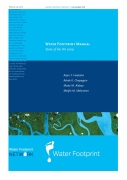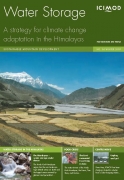Surface Water
Optimum water management in a command area - A research report by National Institute of Hydrology
Posted on 14 Apr, 2010 02:44 PMThis research report by the National Institute of Hydrology deals with optimum water management in a command area. The dynamics of water within the unsaturated zone of soil is a complex phenomenon dependent on properties of the atmosphere, soil and vegetation. For agriculture water management, it is necessary to have models that accurately predict the behavior of soil moisture.
In this study, a model is developed to stimulate the dynamics of soil moisture within the root zone in an agriculture command. Focus is given to incorporate the spatial variation in crop type, soil type and rainfall in the command area and the dynamics of soil-water-plant interaction is stimulated.
Hydrological inventory of South Bihar river basins – A report by National Institute of Hydrology
Posted on 12 Apr, 2010 12:25 PMThis report by National Institute of Hydrology provides a compilation of the hydrological information of seventeen different river basins of South Bihar (now Jharkhand). Hydrological modeling of a basin requires detailed hydrological information about the basin. Further, the hydrological information of a region or a basin is of immense use to water resources planners and managers. However, the hydrological information collected by different organizations are often scattered and are not in representable form.
NBA's indefinite action starts from April 11 : An appeal for solidarity
Posted on 12 Apr, 2010 10:22 AMAriticle Courtesy: National Alliance of Peoples' Movements
Dear Saaathis,
You all must have got the word by now ...Narmada is in serious crisis ...Not just the people and the environemnt, but the very project itself today...And unjust politics is also at its peak again ...This is the last and critical leg of the SSP battle...
Thousands of us are to embark on an indefinite mass action of Narmada from April 11th and sit before the Narmada Control Authority from the 13th at Indore. The situation is very serious and highly politicized, since even as there are 2 lakh adiavasis, farmers, fish workers, labourers yet to be rehabilitated in the submergence area, only corruption has increased ten-fold and gross environmental non-compliance has been exposed by the latest Devender Pandey Committee.
Water Footprint Manual: State of the art - A method of water footprint assessment by the Water Footprint Network (November 2009)
Posted on 11 Apr, 2010 07:37 PM The Water Footprint Manual (2009) by the Water Footprint Network (WFN) is a comprehensive and up-to-date outline of the method of water footprint assessment. It introduces how water footprints can be calculated for individual processes and products, as well as for consumers, nations and businesses.
The Water Footprint Manual (2009) by the Water Footprint Network (WFN) is a comprehensive and up-to-date outline of the method of water footprint assessment. It introduces how water footprints can be calculated for individual processes and products, as well as for consumers, nations and businesses.
The concept is introduced as a comprehensive indicator of freshwater resources appropriation, as against the traditional and restricted measure of water withdrawal. The hidden water use behind products are measured over the full supply chain and water consumption volumes are measured by source and polluted volumes by type of pollution. All components of a total water footprint are specified geographically and temporally. Blue water (surface and groundwater), green water (rainwater stored in the soil as soil moisture) and grey water (polluted water) footprints are defined and are included along with the indirect water use in measuring the overall water footprints.
Water Storage: A strategy for climate change adaptation in the Himalayas - A report by ICIMOD
Posted on 10 Apr, 2010 05:24 PM This report by the International Centre for Integrated Mountain Development (ICIMOD) highlights the phenomenon of climate change and argues that water storage will be a key strategy for climate change adaptation in the coming years.
This report by the International Centre for Integrated Mountain Development (ICIMOD) highlights the phenomenon of climate change and argues that water storage will be a key strategy for climate change adaptation in the coming years.
The report discusses the importance of the Hindu Kush Himalayan ranges as an important source of water to a large section of the population and warns of the impending crisis of water scarcity and food insecurity in the regions of Asia, if water harvesting and conservation efforts are not undertaken. The document argues that water storage thus becomes a central issue, which is very complicated to implement, particularly in the Hindu Kush Himalayan region.
Joint Convergence Guidelines of the National Rural Employment Guarantee Act and Integrated Watershed Management Programme, issued by the Ministry of Rural Development (April 2009)
Posted on 09 Apr, 2010 09:36 PMThe Joint Convergence Guidelines issued by the Ministry of Rural Development (MoRD) in April 2009, attempts to bring about inter-sectoral convergence in the various watershed management programmes being implemented by the different departments under the MoRD. In particular, it deals with the convergence between the National Rural Employment Guarantee Act (NREGA) being implemented by the Department of Rural Development (DoRD) and the Integrated Watershed Management Programme (IWMP) being implemented by the Department of Land Resources (DoLR).
Dams, Rivers & People - Feb/March edition of SANDRP newsletter
Posted on 06 Apr, 2010 05:22 PM
A bi-monthly newsletter - Dams, Rivers & People: February / March 2010 issue of the newsletter
Hihghlights
- Kerala’s initiative to desilt reservoirs: the Euphoria & the Concerns
- Book Review: Why are the rivers source of conflicts?
- Gujarat makes up stories about Sardar Sarovar Project
- Only 13-17% water losses in Mumbai, Chennai, why not Delhi?
- World Bank’s Double speak on Large Hydro: Renewable or not?
- Pakistan: Glacial lake dam threatens Hunza Valley
Jobs viz DevNet
Posted on 06 Apr, 2010 10:38 AM- Project Manager : The Trans-boundary Water Dialogue (TWD) Project
International Union for Conservation of Nature (IUCN)
Location: New Delhi, India
Last Date: April 16, 2010
Water owned by all and used by all
Posted on 30 Mar, 2010 02:17 PMThis is cross posted from my blog (link). I wanted to introduce the idea of common pool resources, on which there is a whole new body of work coming up lately. This had won Elinor Ostrom the 2009 Nobel Prize. For water sector, I believe this theory can definitely yield some new insights. And it all starts with a question "Who owns the water?'
A broken down school in Givha, Saharsa district, Bihar, destroyed in the floods after the Kusaha breached in 2008
Posted on 29 Mar, 2010 12:18 PMWhen the foundation stone for the Kosi embankment was laid on January 14, 1955, near Nirmali in Saharsa district in Bihar, euphoric people shouted, Aadhi roti khayenge, Kosi bandh banayenge (we will eat only half a chapati but we will surely build the embankment), writes the prolific engineer and activist Dinesh Mishra in his book, “ Trapped! Between the Devil and the Deep Waters.” No one really paid any attention to the protests and the fears of the people who would live with these embankments and what would happen to their lives.





